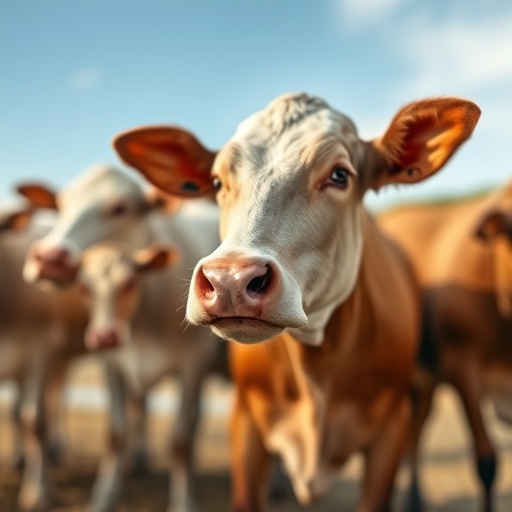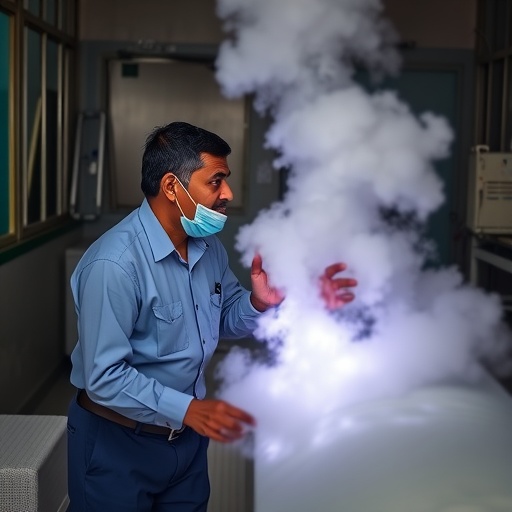In a groundbreaking study that shines a light on the hidden dangers lurking within raw milk, researchers from Abdul Wali Khan University Mardan in Pakistan have uncovered a disturbing prevalence of multidrug-resistant Staphylococcus epidermidis in dairy cattle and ewes. This research, published in the renowned open-access journal PLOS One on November 12, 2025, reveals that antibiotic resistance in bacteria associated with subclinical mastitis could be a significant public health threat, especially in regions where raw milk consumption is predominant.
Raw milk consumption remains a common practice in Pakistan, where over 95% of milk consumed has not undergone pasteurization. This exposes consumers to a variety of bacterial contaminants that survive the lack of heat treatment, including organisms that have adapted to resist multiple antibiotics. Subclinical mastitis—an infection of the mammary gland in livestock that lacks obvious clinical symptoms—is particularly insidious since it allows pathogenic bacteria to multiply invisibly, compromising milk safety and quality without detection. The misuse and overreliance on antibiotics to treat this condition have contributed to an alarming rise in resistant bacterial strains.
The bacterium at the center of this investigation, Staphylococcus epidermidis, is primarily known as a benign skin commensal in humans. However, in the context of raw milk, its role shifts dramatically. It is an opportunistic pathogen causing subclinical mastitis, which diminishes milk yield and quality. By analyzing 310 milk samples evenly split between cattle and sheep, the researchers conducted thorough screenings for subclinical mastitis and isolated strains of S. epidermidis for antibiotic susceptibility testing. Their results echo a worrying story: nearly one in four samples tested positive for subclinical mastitis, and approximately 13% contained S. epidermidis isolates.
The extent of antibiotic resistance found in these isolates is particularly concerning. An overwhelming 95% of the S. epidermidis strains exhibited resistance to penicillin and erythromycin, two widely used antibiotics in veterinary medicine. Moreover, half of the isolates qualified as multidrug-resistant, showing resistance to three or more antibiotic classes. This level of resistance not only complicates treatment options for infections in livestock but also signals a reservoir of resistance genes that could potentially transfer to more virulent pathogens.
The significance of these findings extends beyond veterinary concerns. The presence of multidrug-resistant S. epidermidis in raw milk may facilitate the horizontal transfer of resistance determinants to Staphylococcus aureus, the notorious pathogen responsible for MRSA infections that represent a severe challenge in human medicine. The study highlights a potentially underestimated route of antimicrobial resistance transmission from farm to table, underscoring the interconnectedness of animal husbandry practices, food safety, and public health.
From a microbiological standpoint, Staphylococcus epidermidis has traditionally been overshadowed by its more pathogenic relatives. Yet, its ability to form biofilms and persist in hostile environments, coupled with increasing antimicrobial resistance, demands renewed attention. The milk microbiome becomes a crucible for selective pressure, where antibiotic misuse cultivates strains that evade treatment and can thrive alongside human and animal microbial populations.
The researchers emphasize the urgent need for stringent antibiotic stewardship in agricultural settings. Responsible use encompasses accurate diagnosis, prudent antibiotic selection, and adherence to withdrawal periods to prevent antibiotic residues in milk. Alongside pharmacological interventions, improving hygiene at the farm level—from milking equipment sanitation to animal health monitoring—could drastically reduce bacterial contamination and subclinical infections.
This study also encourages reassessing current agricultural policies and veterinary practices in low- and middle-income countries where raw milk is a cultural staple. The lack of pasteurization combined with high antibiotic use in livestock not only jeopardizes animal health but also endangers consumers by potentially introducing resilient bacterial strains into the food supply. Educational initiatives aimed at farmers and consumers alike are critical to mitigate these public health risks.
Moreover, the authors note that monitoring programs for antimicrobial resistance in dairy sectors need to be expanded to encompass a broader range of bacteria beyond traditional pathogens. Surveillance of commensal and opportunistic species like S. epidermidis could provide early warning signs of emerging resistance trends and guide timely interventions.
The research was conducted by a collaborative team spanning multiple countries, including Pakistan, China, Tunisia, and Chile, reflecting the global dimension of antimicrobial resistance challenges. Funded by a joint project of the Pakistan Science Foundation and National Natural Science Foundation of China, as well as Project MECESUP UCT, the study represents a high-caliber international effort to address a pressing cross-sector health issue.
The compelling evidence presented by this study points to a multifaceted approach to combat the rise of multidrug-resistant bacteria in the dairy industry. Integrating microbiological insights, veterinary best practices, public health policies, and consumer education forms the backbone of such a strategy. Only by combating antibiotic resistance at its source—in this case, the farm environment—can the transmission chain be interrupted, protecting both animal welfare and human health.
In conclusion, the pervasive contamination of raw milk by multidrug-resistant Staphylococcus epidermidis serves as a stark reminder of the unintended consequences of antibiotic overuse and underscores the urgent need to rethink how antimicrobials are deployed in agriculture. This study challenges stakeholders to implement more rigorous controls and innovative solutions to ensure that milk, a vital nutritional resource, does not become a vehicle for disseminating antimicrobial resistance.
Subject of Research: Animals
Article Title: Prevalence and antimicrobial resistance characterization of multidrug-resistant Staphylococcus epidermidis isolated from raw milk of dairy cattle and ewes
News Publication Date: November 12, 2025
Web References: http://dx.doi.org/10.1371/journal.pone.0334516
References: Inamullah, Kamal M, Badshah F, Khan S, Tayh G, Ben Said M, et al. (2025) Prevalence and antimicrobial resistance characterization of multidrug-resistant Staphylococcus epidermidis isolated from raw milk of dairy cattle and ewes. PLoS One 20(11): e0334516.
Image Credits: Inamullah and colleagues, Abdul Wali Khan University Mardan, Pakistan, CC-BY 4.0
Keywords: Multidrug resistance, Staphylococcus epidermidis, raw milk contamination, subclinical mastitis, antibiotic stewardship, antimicrobial resistance, dairy cattle, ewes, food safety, public health, biofilms, MRSA
Tags: antibiotic resistance in dairy cattleantibiotic-resistant bacteria in raw milkbacterial contaminants in dairy productshidden dangers of raw milkimplications for consumer healthmisuse of antibiotics in livestockmultidrug-resistant Staphylococcus epidermidisprevalence of resistant strains in milkpublic health threat of raw milkraw milk consumption in Pakistanrisks of unpasteurized milksubclinical mastitis and milk safety





